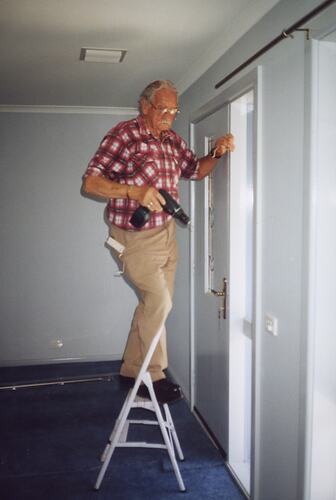Summary
Digitised copy of a colour photographic print of Hubert Halls in a house, standing on a step ladder with a drill in his hand making some repairs to a door, at his granddaughter Emma's home(Sue's daughter) in Hoppers Crossing, circa 2000s.
This photograph is one of 13 relating to the migration and settlement story of Hubert Halls who left Southampton for Melbourne on the MV Fairsea with his wife Dolly and five children in 1963. Hubert and his family lived on the Isle of Wight and he was a carpenter by trade; the images include two photos of Hubert with workmates in England, as well as photos of dockside departure and onboard ship.
Hubert had contracted polio and was ineligible for military service during WWII and he was employed to make coffins for deceased soldiers. In Australia he worked for the Melbourne City Mission until he retired. The collection also includes
two Fairsea shipboard newsletter/ information sheets and a booklet entitled 'A Handbook of Tools of Trade' published by the Commonwealth Dept of Immigration. The book with illustrations of tools and the English name are organised into specific trade groups.
Description of Content
Man wearing red, black and white checked sirt standing on a white step ladder with drill in hand in an interior domestic space.
Physical Description
Digitised copy of a colour photographic print.
Significance
This collection enables the representation through images and artefacts the working life of migrants prior to migrating to Australia and the skills and trades they brought with them. The booklet entitled 'A Handbook of Tools of Trade' published by the Commonwealth Dept of Immigration is an evocative example of methods used by the Australian Government to assist tradespeople adapt to Australian working conditions, especially those of a non-English speaking background. It also speaks to the importance placed by the Dept of Immigration on building a construction and manufacturing workforce. The booklet was produced to 'help the assimilation of migrant tradesmen...Migrants will recognise the tool from the drawing, and will read and learn its English name. Foremen and Australian workmates can help by pointing out in the booklet the tools that the migrants will use, and by helping him with the correct pronunciation.'
The shipboard photographs also document the kinds of activities and entertinments organised for passengers during their migrant voyages.
More Information
-
Collecting Areas
Migration & Cultural Diversity, Images & Image Making, Home & Community
-
Person Depicted
-
Format
Digital Photograph, Colour
-
Classification
-
Category
-
Discipline
-
Type of item
-
Keywords

